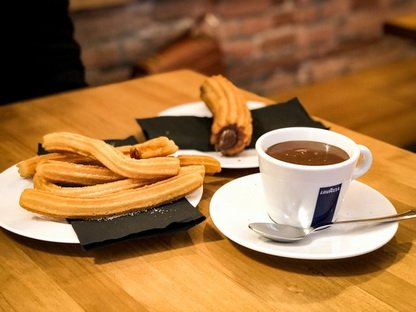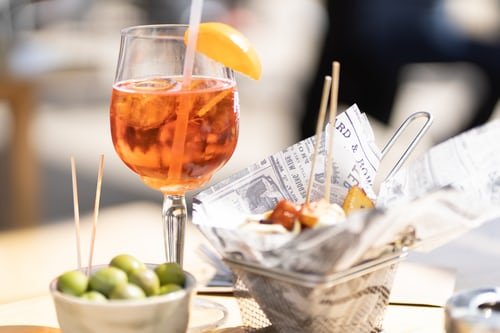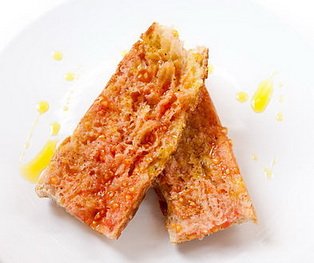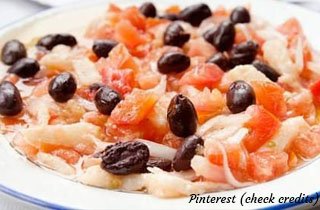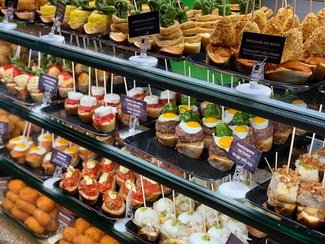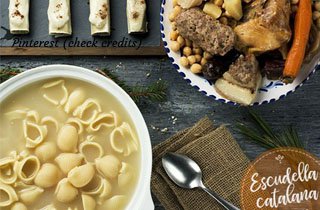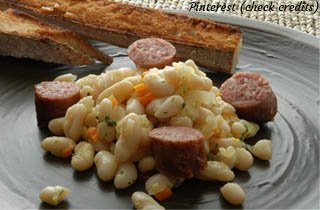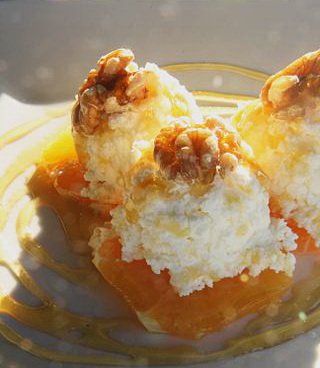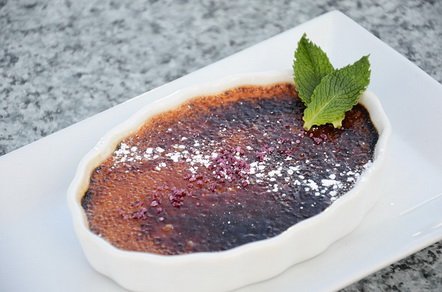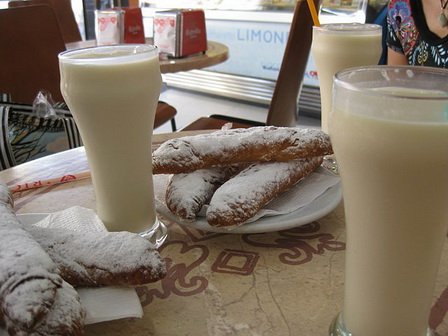To eat or not to eat… good question
what food should you try in Barcelona
To eat or not to eat… what’s the answer?
What for breakfast? – Tapas… La Bomba! – Calçots – Pa amb Tomàguet – Escalivada – Esquiexada de bacalao – Other and sauces – Soups: Sopa de galets – Mains: Fideuà – Butifarra – Mar i muntanya – Other: meat and seafood – Sweets: Mel i Mató – Crema catalana – Xuixo – Drinks: Cava – Orxata
B
arcelona is unforgettable thanks to its ambiance: sunny coast, astounding architecture, interesting history… And what about food?
It is delicious! The city lies on the Mediterranean coast which means that many traditions are coming from there. The rhythm of the day goes alongside the sun – it is too hot to eat even few hours after noon. Breakfast is almost non-existent, but the evening supper or dinner… That is a feast! You start around 9 PM and it seems to go on forever.
This said – during the day there will be few people eating regular food… but then – what is regular for us may not be normal in Barcelona! They prefer to hydrate the body and eat just a small snack… Believe us, you will not be hungry there.
Sweet breakfast
If you prefer traditional, full-sized breakfasts… here you will have some different customs. This meal almost does not exist. If anything, they begin the day with something sweet.
The basic pair is a coffee and a pastry, usually a croissant, ensaimada (spiral form pastry), or churros. Children love cocoa with these Spanish, finger-shaped doughnuts. They can be plain, filled with chocolate or another cream.
If you don’t like sweets, no worries – you will always find some bread or a toast. Spanish loaves are quite tasty and often eaten only with olive oil or tomato, the “tourist version” adds cheese or jamón serrano – the famous, Spanish ham.
Tapas
Spain equals tapas! Bars and restaurants serving these treats can be found everywhere. You can spend the whole evening drinking and eating.
Why not call them bites, since they are just small portions of food. If you order enough – they can turn into dinner!
The word comes from Spanish tapar (to cover) since a saucer with food was covering the glass in faraway times. There is also a story that King Alfonso X the Wise (XIII century) liked his wine served with small portions of food. This was his way to fight digestive problems. It worked! Afterward, he made it obligatory that all the taverns serve this special “cure” with wine.
Every region of Spain has its own tapas. Which one is the most popular and local in Barcelona?
La bomba
Recipe link
It is also called la bomba de barcelonetta. These are meat and potatoes croquet mixed with onion simmered in white wine.
Somewhere around the fights with the forces of General Franco, the soldiers used to throw small grenades that wreaked havoc among the citizens of Barcelona. A local chef was inspired by this story and created a ball size of a golf ball. He served it with red brava sauce (of the color of blood) and alioli sauce – white like a burning fuse.
This still is the most common way to serve it and you will be quite happy to try it.
Calçots
If you have ever heard about grilled chives, you won’t be surprised by… grilled leak! It is heavily cultivated in Catalonia, so no wonder they love to eat it. Watch out! it is a seasonal tapas – served from December till March.
Eating it is a sort of a challenge but there is a saying in Poland – “a dirty child equals happy child“. So true… and delicious in this case. The leaks are grilled so close to the heat that they sometimes turn black because of the ashes. The skin is crunchy, but you don’t eat it – the soft insides are juicy and delicious. But you need to get to them…
Try it with tomato-garlic salad or romesco sauce. Street vendors also have grilled meats that go well with calçots. You won’t regret it.
Pa Amb Tomàquet
Call it a Catalonian bruschetta.
The name comes from the grilled bread called pa de pages. You scrape a clove of garlic all over it and add tomato puree. People love it any time of the day – breakfast till supper. It is both a tapas and an addition to other dishes.
Dcwtours love it with anchovies olives.
Escalivada
Recipe link
It is a salad prepared from baked paprika, aubergine, and onion dipped in olive oil and served cold.
The name comes from Spanish escalivar which means burned. The skin of the vegetables should be wrinkled in the process – either by baking, roasting, or grilling. The salad is served alone, with toasted bread or pa amb tomàquet.
Esqueixada… de bacalao?
Recipe link
What is the origin of the fish used in this salad no one knows, or rather remains silent… (it is either Northern Europe or Portugal). One thing is certain – salted cod was the most popular Atlantic product in the XV century Spain. It remains so today, but mostly for the Basque region and Portugal.
The Catalans like to add it to a special of tapas that is satisfying but not yet filling. You can try it in many places, and Barcelona will be a great destination to do so (bacalao/bacallà – the name of the salted cod).
The ingredients are chopped tomatoes (dah!), red peppers, onions, black olives, and fish. Everything sprinkled with olive oil, the true, Spanish gold. Sometimes they add green leaves for contrast, but it is not necessary.
On hot days it is the perfect salad, both nourishing and refreshing. Both zesty and sweet because of the veggies, with the salt from cod and bitterness from olives. It is best from the fridge – full of the juices of tomatoes, that will quench your thirst. You can eat esqueixada without the cod – all is possible. They also like to serve it with pa and tomaquet.
Other tapas and sauces
You can also try some of the famous, Spanish tapas. Patatas bravas are deep-fried potatoes (not fries!) with sauce. Tortilla de patatas is eaten in small slices or as a breakfast omelet.
Barcelona likes carpaccio made from mushrooms, salmon with ricotta, and sardines with tomatoes. The classics are marinated olives, mariscos – seafood bites, chorizo (local sausage with paprika), and jamón serrano (Spanish, cured ham). Smaller bites tend to be ordered with pa amb tomàquet.
In the seafood department… try gambas (prawns), chipirones (squid), or cargols – snails with garlic. Cargols are Catalonian in origin, but you can eat it in other parts of Spain too (the dish is called Cargos de la laguna).
Typical Catalonian sauces are:
- sofrito (garlic, onion, tomatoes, olive oil)
- alioli (garlic, olive oil)
- picada (baked almonds, pine nuts, cinnamon, parsley, saffron)
- samfaina (tomatoes, aubergine, pepper, onion, spices, olive oil)
- romesco (hot peppers, tomato, onion, nuts, olive oil, vinegar) – perfect with calçots, although it comes from Tarragona.
Dinner, supper, both
Spanish lunchtime is often eaten as the first course of the day, between 1- 4 PM. No one should bother you at this time – it is the siesta time; it is sacred, and it is widely respected.
Almuerzo is the word for lunch. You typically eat tapas or a sandwich (bocadillo/bocata) at that time. The true feast starts in the evening…
Sopa de Galets
Recipe link
It is a traditional, Catalonian broth made from different kinds of meats. The main ingredient is a shell-shaped pasta called galets. The soup has been known for over a thousand years. Today it is usually cooked during X-mas. Winter is the best time for this hot broth.
Before, in the times when life was hard, it was served the whole year as an easy, nutritious dish (pasta can be stuffed with meat). In the XIV century, it was commonly 568eaten with bread.
Although it is corn d ‘olla (the above soup) which is the typical soup of Catalonia, you can taste the Spanish ones as well. Gazpacho is the most favorite and it is more a vegetable drink than a soup. It is eaten cold, and the main ingredient is a tomato. Zarzuela, on the other hand, is a soup-goulash. It is served hot in colder, winter months. It is thick with different kinds of fish, seafood, and potatoes.
Fideuà or paella
Nothing easier… fideuà is a Catalonian paella. Instead of rice, you have short, fides pasta (vermicelli-like in looks) in it. It is usually served with seafood.
Everything else, the way of preparation and the looks are almost the same.
The dish is prepared on a flat frying pan/serving platter. The secret lies in ingredients: al dente fides and both juicy and crunchy seafood. Finally – the presentation! It is always some artistic composition.
Other notable paellas in Barcelona are meat, fish, or vegetable rice dishes. Paella de marisco is quite popular and made with prawns, calamari, and clams. You should also be amazed by Arroz Negro – a black paella, prepared with the calamari ink.
Butifarra
Recipe link
It is a kind of a spicy sausage made of chopped, pork meat. It is usually grilled, served with a salad and potatoes.
It is also a part of many Catalonian dishes. Paired with beans it creates something like English bangers and mash.
Botifarra negra is a type of blood pudding. It is the main ingredient of Faves a la Catalana. It is an aromatic goulash with beans, bacon, and spices.
Mar i muntanya
Recipe Mandonguilles amb sipia
Recipe Pollo amb llagosta
It is not only a dish, as a Catalonian tradition where the gifts from the land and from the sea are combined. In other countries, it is sometimes called surf n’turf.
In the past, it was both a way to fight hunger and a way to imitate the life of wealthy people. The fishermen were depending on fish and seafood they were gathering on the shores. This was their main diet. Vegetables and beans made a fish stock thick, so the people didn’t feel the hunger so much.
But a festive version was invented, and it had an addition of meat. Meat that was eaten mostly by the aristocrats. It made the fishermen forget about their everyday struggles.
Today, the most popular dishes are chicken with lobster (pollo amb llagosta) and meatballs with cuttlefish (mandonguilles and sepia).
Other
Seafood and fish are popular all over Spain. In Barcelona, the cod (bacalao) is the main actor. For dinner, they like it with a vegetable sauce, garlic, and tomatoes.
But grilled fish, pasta, and salads with seafood are always welcomed.
Cargols have the second place – snails in garlic are a local treat (on the photo) eaten as tapas and as a full dish.
The meats are eaten in winter. Summer is a time of jamón and chicken – they are light on the stomach and taste well while eaten cold.
If you come here in less of a tourist season, try some of the home dishes. Examples:
Lomo con huevos y patatas
grilled pork with egg and potatoes. it may be compared to a Schnitzel
Pollo asado a la catalana
chicken in a special sauce made of prunes, cinnamon, almonds, and pine nuts
Canelons
sounds Italian but here, the pasta rollers are stuffed with shredded meat
Mel i Mató
What somewhere else is called ricotta, here is called mató.
Catalonians love their goat cheese with honey and nuts. It is quite delicate in taste and the accompaniments are balanced – honey brings this special kind of sweetness and nuts are crunchy and bitter. Those who do not like overly sweet desserts should be happy.
Some say it is a Spanish sweet, but don’t say it out loud in Catalonian. The origins of some dishes shouldn’t be discussed.
Crema Catalana
According to a legend, Catalonian nuns created it by mistake while preparing a pudding to greet the bishop.
The dessert turned out to be too runny. They wanted to hide it, so it was covered in sugar, which was then burned. The effect was stunning and crunchy.
Some compare it to the creme brulée… But here, again, no discussions. Try the Spanish version and decide which one you like better.
Xuixo
This cake/donut is filled with crema catalana. You will get it everywhere. The pastry may be described as viennoiserie, but then not quite… It depends on the place you buy it.
Xuxo is often replaced by melindros (soft cakes) when it accompanies coffee. It is more filling than the sweet fingers, which are only for two bites. In the coffee department – Spaniards love cortado. It is not macchiato and it has more milk inside… It is served in an espresso cup or a small glass, where it looks like a miniature cappuccino.
One is certain – the bitterness of coffee and the sweetness of pastry are perfect for breakfast, give you energy for lunch or for the “tea-time”.
Cava and wine
You are wondering what to drink in Catalonia? Wine is the answer (beer has a second place).
The most notable of all is cava, produced in the neighboring region of Penderes. It is a sparkling wine, but you will find some others too.
Cava is perfect with seafood and tapas.
In the department of red wines? Try Torres Gran Coronas, Raimat or Jean Leon. The wine from Priorat is strong and expensive. There is a wide variety of red, white, and sparkling wines. You will love their taste. Try them chilled – this way they are even better.
Sangria is popular as well. It is made of wine, fruits, and brandy. Tourists prefer it over cava, but not Catalonians. The local version may be quite different from the southern one – they mix wine with sprite or lemonade.
Orxata
It is a drink made from almonds and milk. They serve it warm or cold. It comes from Valencia, although it is the Moors who were responsible for bringing it to Spain in the first place.
It even went to the New World where it was given a second life and identity!
Orxata was reinvented in the XIII century by king Jacob I the Conqueror. Once in Valencia, he tasted a sweet, milky drink… He shouted Aço és or, xata! which in translation means “this is gold!!


